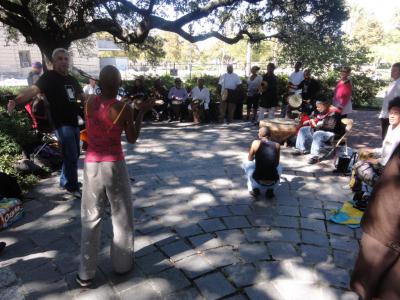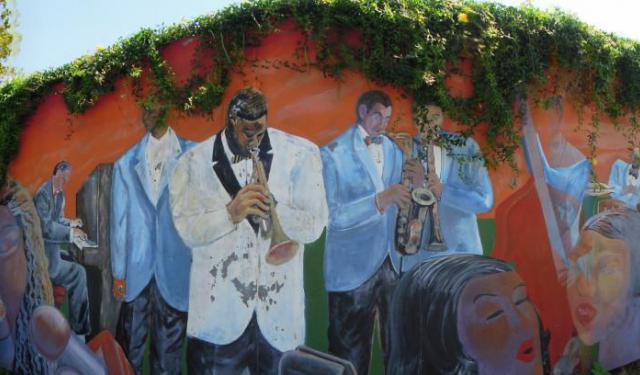Congo Square, New Orleans
The earliest Africans to arrive in Louisiana were brought as slaves in 1719 from the Senegambia region. Slavery was widely accepted in New Orleans, and over time, some Africans managed to obtain their freedom, becoming known as "free people of color". Many of these "freemen" were well-educated and were the descendants of black mothers and French or Spanish settlers.
In addition to culinary knowledge, African settlers brought their native music and spiritism in the form of the Voodoo religion. Congo Square, now part of Louis Armstrong Park near the French Quarter, served as a gathering place for both slaves and free people of color. This was particularly true on weekends when the Square transformed into a site for exotic tribal dances and celebrations.
The slave dances at Congo Square were a unique attraction for visitors to New Orleans. Herbert Asbury, in his book "The French Quarter", describes one such gathering: "The favorite dances of the slaves were the Calinda, a variation of which was also used in the Voodoo ceremonies, and the Dance of the Bamboula, both of which were primarily based on the primitive dances of the African jungle, but with copious borrowings from the contra-danses of the French . . . The male dancers attached tin or other metal to ribbons tied about their ankles. Thus accoutered, they pranced back and forth, leaping into the air and stamping in unison, occasionally shouting "Dansez Bomboula! Badoum! Badoum!", while the women, scarcely lifting their feet from the ground, swayed their bodies from side to side and chanted ancient song . . . The entire square was an almost solid mass of black bodies stamping and swaying to the rhythmic beat of the bones upon the cask, the frenzied, chanting of the women, and the clanging of the pieces of metal which dangled from the men's ankles."
The African instruments, such as drums and banjos, as well as the songs, eventually gave rise to street bands and, later, the development of jazz music. However, as the gatherings at Congo Square raised concerns among New Orleans citizens, who feared slave uprisings, they were restricted to Sunday daylight hours only in 1817.
Marie Laveau, often referred to as the first and most powerful "Voodoo Queen" of New Orleans, is one of the most well-known practitioners of Voodoo associated with Congo Square. In the 1830s, she not only led Voodoo dances but also organized more secretive rituals along the shores of Lake Pontchartrain and Saint John's Bayou.
In addition to culinary knowledge, African settlers brought their native music and spiritism in the form of the Voodoo religion. Congo Square, now part of Louis Armstrong Park near the French Quarter, served as a gathering place for both slaves and free people of color. This was particularly true on weekends when the Square transformed into a site for exotic tribal dances and celebrations.
The slave dances at Congo Square were a unique attraction for visitors to New Orleans. Herbert Asbury, in his book "The French Quarter", describes one such gathering: "The favorite dances of the slaves were the Calinda, a variation of which was also used in the Voodoo ceremonies, and the Dance of the Bamboula, both of which were primarily based on the primitive dances of the African jungle, but with copious borrowings from the contra-danses of the French . . . The male dancers attached tin or other metal to ribbons tied about their ankles. Thus accoutered, they pranced back and forth, leaping into the air and stamping in unison, occasionally shouting "Dansez Bomboula! Badoum! Badoum!", while the women, scarcely lifting their feet from the ground, swayed their bodies from side to side and chanted ancient song . . . The entire square was an almost solid mass of black bodies stamping and swaying to the rhythmic beat of the bones upon the cask, the frenzied, chanting of the women, and the clanging of the pieces of metal which dangled from the men's ankles."
The African instruments, such as drums and banjos, as well as the songs, eventually gave rise to street bands and, later, the development of jazz music. However, as the gatherings at Congo Square raised concerns among New Orleans citizens, who feared slave uprisings, they were restricted to Sunday daylight hours only in 1817.
Marie Laveau, often referred to as the first and most powerful "Voodoo Queen" of New Orleans, is one of the most well-known practitioners of Voodoo associated with Congo Square. In the 1830s, she not only led Voodoo dances but also organized more secretive rituals along the shores of Lake Pontchartrain and Saint John's Bayou.
Want to visit this sight? Check out these Self-Guided Walking Tours in New Orleans. Alternatively, you can download the mobile app "GPSmyCity: Walks in 1K+ Cities" from Apple App Store or Google Play Store. The app turns your mobile device to a personal tour guide and it works offline, so no data plan is needed when traveling abroad.
Congo Square on Map
Sight Name: Congo Square
Sight Location: New Orleans, USA (See walking tours in New Orleans)
Sight Type: Attraction/Landmark
Guide(s) Containing This Sight:
Sight Location: New Orleans, USA (See walking tours in New Orleans)
Sight Type: Attraction/Landmark
Guide(s) Containing This Sight:
Walking Tours in New Orleans, Louisiana
Create Your Own Walk in New Orleans
Creating your own self-guided walk in New Orleans is easy and fun. Choose the city attractions that you want to see and a walk route map will be created just for you. You can even set your hotel as the start point of the walk.
Top Religious Sites Walking Tour
New Orleans has some of the oldest and most beautiful churches in Louisiana. Some of them, like the St. Louis Cathedral, have become iconic symbols of the city, while others are considered to provide "fresh air" to the busy business quarters.
The churches on this walking tour combine different architectural styles, starting with the Spanish Colonial & French Neo-Gothic design of... view more
Tour Duration: 2 Hour(s)
Travel Distance: 4.0 Km or 2.5 Miles
The churches on this walking tour combine different architectural styles, starting with the Spanish Colonial & French Neo-Gothic design of... view more
Tour Duration: 2 Hour(s)
Travel Distance: 4.0 Km or 2.5 Miles
African American Heritage Walking Tour
For over 300 years, the African-American community has played an intrinsic role in creating authentic New Orleans that everyone loves today. The bedrock of the city's life is built on the African-American experience, a heritage both proud and tragic, yet strong enough to have preserved throughout centuries the many aspects of African culture, influencing everything from religion to vibrant... view more
Tour Duration: 2 Hour(s)
Travel Distance: 3.6 Km or 2.2 Miles
Tour Duration: 2 Hour(s)
Travel Distance: 3.6 Km or 2.2 Miles
Voodoo Tour
Voodoo is an ancient ritualistic practice brought by enslaved West Africans onto the American soil upon their arrival in the 18th century. This form of religion was most prominent in New Orleans from the 1820s through the 1860s, when it was introduced by the “Voodoo Queens”. Of these, Marie Laveau became more prominent as she overthrew other queens to become the sole oracle.
Your best... view more
Tour Duration: 1 Hour(s)
Travel Distance: 2.6 Km or 1.6 Miles
Your best... view more
Tour Duration: 1 Hour(s)
Travel Distance: 2.6 Km or 1.6 Miles
Garden District Walking Tour
It may come as a surprise, but New Orleans’ Garden District is known for its architecture more than for its gardens. The city’s elite residential neighborhood since the 19th century, when wealthy newcomers built opulent structures, it is considered one of the best-preserved collections of historic mansions in the South, and certainly one of the most picturesque. You can see why this is the... view more
Tour Duration: 1 Hour(s)
Travel Distance: 1.9 Km or 1.2 Miles
Tour Duration: 1 Hour(s)
Travel Distance: 1.9 Km or 1.2 Miles
French Quarter Walking Tour
The French Quarter, also known as the Old Square, is New Orleans' oldest and most popular neighborhood. Founded in 1718, it perfectly combines the tempting, noisy and nutty nightlife of Bourbon Street with important historical landmarks, art galleries, sophisticated cafés, and some of the city's oldest churches – all within walking distance, close to Mississippi River.
On this... view more
Tour Duration: 2 Hour(s)
Travel Distance: 3.4 Km or 2.1 Miles
On this... view more
Tour Duration: 2 Hour(s)
Travel Distance: 3.4 Km or 2.1 Miles
French Quarter Historical Buildings Walking Tour
Widely known for its heritage sites with a variety of unique architectural styles, New Orleans has lots of beautiful buildings designed in the Greek Revival, American Colonial, or Victorian styles. Walking around the French Quarter, you'll enjoy these old historic buildings (some open to the public), their old ironwork gates and balcony railings, the antique brick- and stone-paved sidewalks... view more
Tour Duration: 2 Hour(s)
Travel Distance: 2.3 Km or 1.4 Miles
Tour Duration: 2 Hour(s)
Travel Distance: 2.3 Km or 1.4 Miles









